| Apr-22-18 | | fisayo123: How many more failed conversions will I have to endure from Ding Liren? It's becoming comical at this point. Maybe he has to improve his physical condition and hit the gym because he looks very frail. I can't understand how a world class player can play so well in the middlegame then just continually squander advantages. Not just missing the zugzwang with a6 (which he wont have missed if he played intuitively and made the natural move Ka3). He also played <26. Re6?> instead of the obvious Rc6 <32. Kg7?> instead of Kh7 getting out of the diagonal, allowing g5 instead of playing 31...h5 where white has no real moves. Basically every opportunity he had to win he messed up. Its just astonishing to me. Either he's a choke artist or is severly lacking stamina over the full duration of the game. If he can improve his conversion he's a top 5 talent. If not he'll stay where he's been for the last 3 years. |
|
| Apr-22-18 | | WorstPlayerEver: 64. Ke4
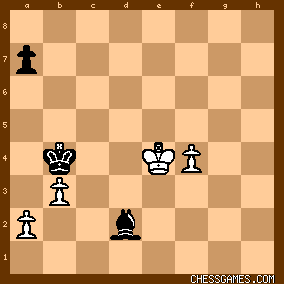
click for larger viewAs a patzer it's hard to understand why Ding played 64... Kc5 here. 64... Ka3 seems the only way to go for the win. I don't count 64... a6 (computer move). |
|
Apr-22-18
 | | SwitchingQuylthulg: Black needs to play ...a6 at some point to win anyway, on move 65 or 66 at the latest; the more straightforward approaches, without ...a6, are all draws. Here, for example (after 64...Ka3 65.f5 Bb4 66.Kd3)... 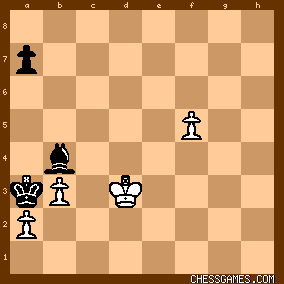
click for larger view...the only winning move is 66...a6. ...a6 is necessary to stop Kb5, but it is indeed a non-obvious idea, and if you calculate these lines without seeing ...a6 they look like a draw. In particular, 64...Ka3 65.f5 Kxa2? (a more obvious continuation) draws. It's also not trivial to calculate 66...a6 to a win, even if it is seen - 66...a6 67.Kc4 Be7! (only move) 68.Kd5 Kxa2 (only move) 69.Kc6 Bb4! (only move) - the bishop needs to move back and forth between b4 and e7 in the space of three moves, not an easy maneuver to see in advance. That said, yes, ...Ka3 is a more intuitive winning attempt than ...Kc5. |
|
| Apr-22-18 | | WorstPlayerEver: <SwitchingQuylthulg> It's hard to comprehend a7-a6, given the position, but it indeed stops Kc4-b5 after 66... Ka3×a2 67. Kc4 Ka3 68. Kb5= Very interesting! Because a7-a5 also leads to Kb5 whereupon Black can't defend both a5 and White's f-pawn if Black plays Kxa2 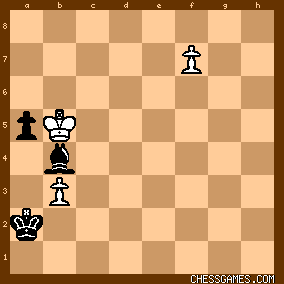
click for larger viewBlack to move |
|
Apr-22-18
 | | AylerKupp: <WorstPlayerEver> As a patzer it's hard to understand why Ding played 64... Kc5 here. 64... Ka3 seems the only way to go for the win.> As a matter of fact, the position after 62...Bxd2 is a theoretical tablebase win for Black.
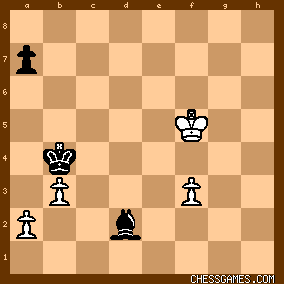
click for larger viewI say "theoretical" because, as you pointed out, this is a game between two human players and there's a limit to how far ahead they can accurately calculate regardless of the time they have available. I don't understand 64...a6 either. If the intent is for Black to give up his bishop for White's f-pawn (after, say, f4-f5, ...Bh6, and the eventual f8=Q, ...Bxf8, then 64...a5 to me seems more effective and quicker. Not only does it advance Black's a-pawn more, but after an eventual ...Ka6 it hinders b3-b4 so it makes for a quicker ...Kxb3. Yet, 65...a5 is a theoretical tablebase draw. Aaah, the sweet mysteries of chess. So you're right, 64...Ka3 is the only way for Black to guarantee a win if you discount 64...a6. The FinalGen tablebase generator indicates that of all the legal moves for Black from this position

click for larger view64...Bxf4 draws, 64...Be3 (not surprisingly) loses for Black (but FinalGen looks at every possible move), and every other move would result in a draw for White with best play by both sides. So now my only question is: Why does 64...a6 win? But I'm not curious enough to spend the time investigating it, particularly since I doubt that Ding Liren (or any other human player) would have played that. |
|
| Apr-22-18 | | WorstPlayerEver: <AylerKupp>
Studying with Lomonosov7, 64... a6 65. e4 Kb4 66. f5 Ka3 67. Kd3 Bb4 #diagram1 the 'winning position'. 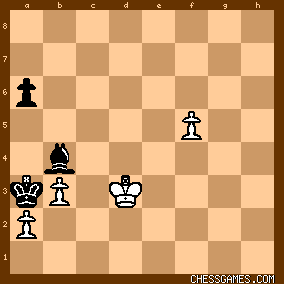
click for larger viewNow 68. Kc4 Be7 wins but it's still very complicated! 69. Kd5 Kxa2 70. Kc4 Ka3 71. Kc3 a5 72. Kc4 Bd8 73. Kc3 Ka2 74. Kc4 Kb2 #diagram2 and now White loses the b3 pawn. 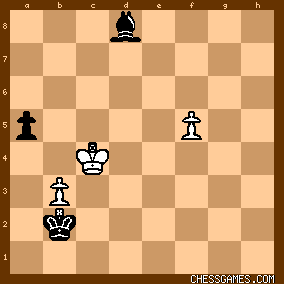
click for larger view |
|
| Apr-22-18 | | Gregor Samsa Mendel: <AylerKupp--Why does 64...a6 win? But I'm not curious enough to spend the time investigating it, particularly since I doubt that Ding Liren (or any other human player) would have played that.> I disagree with the assessment that it was not humanly possible to see that keeping the white king away from b5 at a critical moment was key to winning this position. A patzer like me was able to figure it out after a few minutes of pushing the pieces around a magnetic board, without the aid of computers or tablebases. I think it would have been within the ability of a top grandmaster to see this after some thought. |
|
| Apr-22-18 | | not not: Is it Giris or Lirens immortal or both? |
|
Apr-22-18
 | | SwitchingQuylthulg: 64...Ka3 and 64...a6 transpose; they're the same winning line, just with a different move order. |
|
Apr-22-18
 | | AylerKupp: <Gregor Samsa Mendel> Well, unfortunately that justifies my statement somewhere else that I'm not capable of figuring out this endgame. It turns out that I'm not even capable of figuring out what's humanly possible and what isn't. Unless - are you sure you're human? :-) |
|
| Apr-22-18 | | Gregor Samsa Mendel: <AylerKupp--...Unless - are you sure you're human?> None of your beeswax. |
|
| Apr-22-18 | | Whitemouse: Ding got nervous. |
|
| Apr-24-18 | | BOSTER: < AylerKupp>:< I don't understand 64...a6>.
The construction pawn a6 and Bishop b4 makes pawn a6 untouchable because
White king can't move through line a5-b5-c5.
Move <64...Ke3> is illegal.
This ending is so interesting that I recommend like <POTD> black to play 64... |
|
| Apr-24-18 | | WorstPlayerEver: <Studying with Lomonosov7, 64... a6 65. e4 Kb4 66. f5 Ka3 67. Kd3 Bb4 #diagram1 the 'winning position'.> There's a move too much in the whole variation lol Corr: 64... a6 65. f5 Ka3 66. Kd3 Bb4 #1

click for larger viewIt's ironic. If White plays 66. f6:
64...a6 65. f5 Ka3 66. f6 Kxa2 67. Kd3 Bb4 68. Kc4 Ka3 #2 
click for larger viewThe song remains the same, however.
The make the picture complete, let's go back where Ding went wrong. 64. Ke4 #3

click for larger viewI think that one of the most confusing parts of chess is that pieces cross one and other at a given square. Even your own pieces! Here it is to see Kb4-Ka3-Bb4, I am convinced it must have played a role in Ding's decision. Again, even if Ding has calculated it during the game, he also had to combine this idea with the a6/Kb5 idea, to both stop the f-pawn, eat a2/b3, AND to promote his own a-pawn. On top of it he had to imagine several exact positions til 19 ply deep. No easy win to find with only so many minutes left. In hindsight it's clear that the solution came down to the activation of all the Black pieces. They had to work together in perfect harmony. There was only one way to go. If you did figure out how to finish all tasks required in this position, you had to think like John&Yoko. But I bet you didn't. Something to take in consideration the next time you perform one of your stupid (chess) activities. Or maybe a little earlier. Who knows. |
|
| Apr-24-18 | | hoodrobin: Why is Giri so clever in drawing games? |
|
| Apr-24-18 | | john barleycorn: it is a god given talent |
|
| Apr-25-18 | | Munx: Why not 47 ...Qg6+, 48 Kh1 Qh3+ 49 Kg2 and unleash the bishop |
|
| Apr-25-18 | | Munx: Oh ... Blocked by the opposite :) |
|





